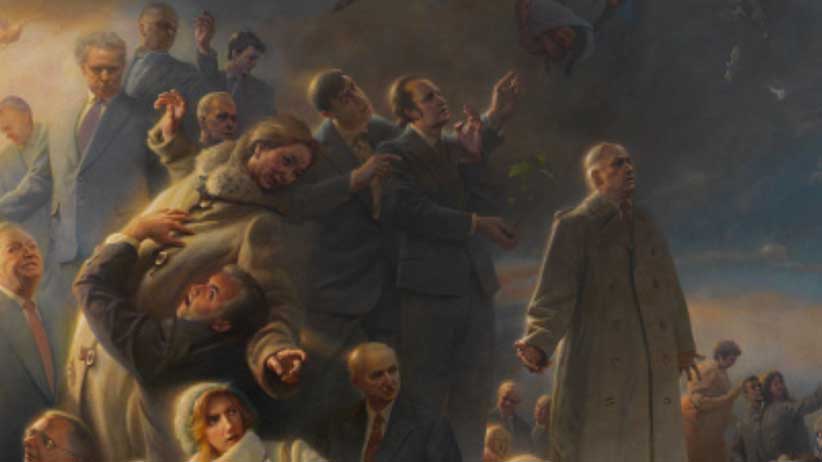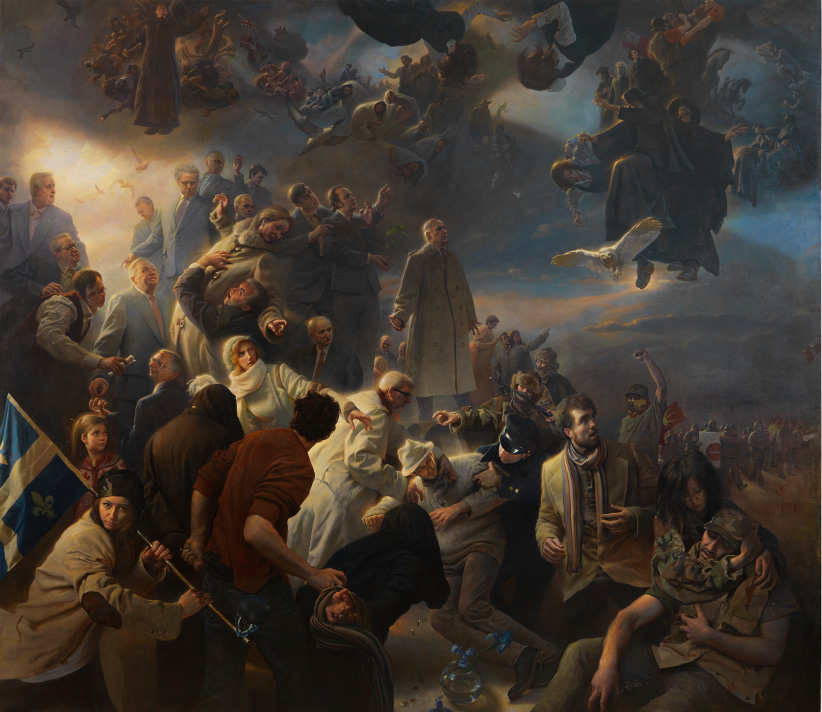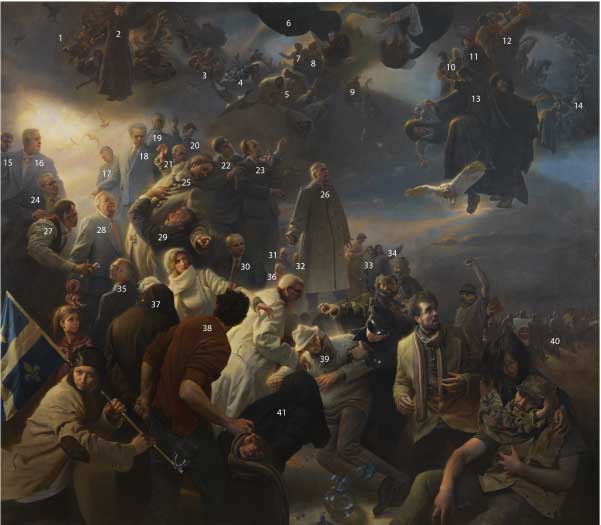
A section of the painting “Quebec” by Adam Miller.
ADAM MILLER
Adam Miller’s ‘Quebec’: An American’s view of La belle province
A young artist from Oregon gives the Old Masters treatment to 400 years of Quebec history
—
Among the most iconic paintings in art history are those of decisive moments created by outsiders. The German-born Hans Holbein the Younger immortalized a swaggering Henry VIII; the Flemish painter Peter Paul Rubens produced 24 epic scenes of French Queen Marie de’ Medici’s life; the German-American Emanuel Leutze rendered the illustrious American Revolution painting Washington Crossing the Delaware, and Pennsylvania-born Benjamin West depicted France’s loss of Quebec with The Death of General Wolfe.
This week the tradition continues when Quebec, by 38-year-old Adam Miller, an artist born in Eugene, Ore., is unveiled at the McCord Museum in Montreal; it travels to Quebec City’s Musée national des beaux-arts on November 14. According to renowned art historian François-Marc Gagnon, who has co-authored an eponymous book on the painting (to be released this month by McGill-Queen’s University Press) the nine-by-10-foot work of 400 years of the province’s history is a masterful “witness of our times” that is also “completely out of fashion with today’s art world.”
The figures of René Lévesque and Pierre Elliott Trudeau occupy the centre of Quebec, while two unnamed Mohawk warriors from the 1990 Oka Resistance dominate the painting’s foreground. Over 30 other of the province’s foremost figures comprise the rest of the work. All are rendered in a style and technique that draws from 17th-century Baroque art. It is the first painting of its kind to present an epic narrative about the country since Benjamin West’s legendary masterpiece. “This sort of work ceased to exist,” says Gagnon, “as photography and cinema took over as a visual documentations of current events. At the same time artists—as well as the schools that taught them—began favoring works of abstraction.”
Miller has no qualms about swimming against the current of contemporary art. “I have always been at odds with authority,” he says. In grade school I remember getting kicked out of class for not standing during the pledge of allegiance.” Another moment he recalls from his adolescence is receiving a Michelangelo calendar for Christmas at age 14. Until then Miller had been interested in comic books and illustration, but seeing pictures of the Sistine Chapel made him aware of works “that I didn’t know existed but was drawn to immediately. I was catapulted into a new world.”

“Quebec” painting by Adam Miller.
ADAM MILLER
To learn how to paint large mythical narrative scenes, Miller, considered a formal training at Portland’s Pacific Northwest College of Art. When its administration told him that he “knew enough about drawing and would be taught to paint abstractly,” Miller went to Italy instead, enrolling at the Florence Academy of Art. More interested in Rembrandt than Rothko, he felt perfectly at home in Europe learning the techniques of Old Master painters. (In keeping with that tradition, Quebec was drawn with charcoal, then under painted, then painted with colour.)
While in Italy, Miller read authors Carl Jung and Joseph Campbell, which fuelled his interest in mythology, and visited as many museums as he could, to see firsthand the masterpieces of 16th-, 17th-, and 18th-century painting.” In addition to Michelangelo, Rubens and the French Romantic painter Anne-Louis Girodet also became sources of inspiration.
In 2012, Miller relocated to Manhattan (today he is based in Brooklyn) and began taking classes with the late American portrait artist John Nelson Shanks, whose commissions included paintings of Dianna, Princess of Wales; Bill Clinton; and Pope John Paul II. Living in the heart of the art world Miller spent time digesting what others were doing while trying to trust his inner voice that being “out of sync with the contemporary scene was the right path to follow,” he says.
Miller’s conviction paid off when his 2013 series “Twilight in Arcadia,” a body of works about contemporary hunters who invade a bucolic mythological paradise, caught the attention of the media as well as art historians, who recognized Miller’s virtuoso skill and narrative prowess. “It felt like something really clicked,” he recalls.
Among those drawn to the artist’s work was the Montreal businessman, philanthropist and arts patron Salvatore Guerrera. Like Miller, Guerrera admired the genre of epic history painting. For years he would be up at night trying to find contemporary painters working in the spirit of the Great Masters. After spotting Miller’s art online, Guerrera thought, “I have to meet this guy.”
With talk of Canada’s 2017 celebrations in the air, Guerrera had a commission in mind. “The year is important not just because it marks the anniversary of Confederation,” he says, “but the founding of Montreal 375 ago, 35 years of Canadian Charter of rights, and 225 years of parliamentary institutions in Quebec.” Guerrera visited Miller’s Brooklyn studio and asked him if he might paint “a storyboard of many stories about Quebec and Canada,” because, he says, “there is no better communication tool than art.”
The son of Italian immigrants, Guerrera spoke neither French nor English as a child. “The textbooks that fascinated me the most were the ones with drawings of scenes from history. Learning about this country and its languages had everything to do with those pictures. Those grade-school images never left me.” As an adult Guerrera travelled to the museums and cathedrals of Europe and wondered why Canada lacked large-scale paintings of the country’s history.
Guerrera considered commissioning the Cree artist Kent Monkman, whose work he owns, and who is renowned for his clever revisiting of traditional historical narratives. Ultimately, however, he felt that Miller’s realist style would allow for a better presentation of history’s characters. Although Miller knew little about Canada, it never crossed Guerrera’s mind that he could not handle the job. “The great Old Masters tackled foreign stories and subjects all the time,” he says.
Miller began his work on the painting by embarking upon a rigorous, two-year study of the province’s history, one that included multi-hour conversations with 12 experts, including Gagnon, historian Peter Gossage, and former Québec premier Lucien Bouchard, all of whom he asked the same question: What was important in the making of Quebec, and what is the story of its future?
By mid-2015 he was ready to start painting Quebec, which features two central themes, both visible along a dominant horizontal axis that moves from the work’s top left corner to its bottom right: France’s colonization of Indigenous land that became known as Quebec, and the English-French tensions that consumed the province and the country.
Not everyone in the painting is from the province. Former Prime Minister Kim Campbell is included in the work, as is Louis Riel. “I didn’t want the picture to be Quebec in isolation since Quebec isn’t in isolation,” says Miller. Following a Renaissance art tradition, he painted a self-portrait into the work (he’s the bearded man in the foreground wearing a striped scarf). “I am the stand-in for the person who’s trying to figure out what’s going on,” Miller says. “It’s an acknowledgement of myself as the outsider.”
In the painting’s bottom left an anonymous young woman holds the province’s flag. Miller explains that she is a nod to Eugène Delacroix’s illustrious painting Liberty Leading the People (created to commemorate the July Revolution of 1830) and “a symbol of Quebec as an orphan, a colony that was abandoned.” To her left are citizens who were critical to Quebec’s key historical movements, including the October Crisis. Politicians, among them Pauline Marois and Justin Trudeau, fill out the work’s centre. At the top, you have what Miller calls “the ghosts of history.” These include Samuel de Champlain, considered “the father of New France”; Chef Donnacona, who was kidnapped from his village of Stadacona and brought to Europe by Jacques Cartier in 1536; and les filles du roi, young women who between 1663 and 1673 moved to New France to marry its settlers.
Collectively the characters of Quebec command their viewers’ attention. It is hard to look at the painting without wanting to learn more about the individuals in it and how they contribute to the nation’s history. “Fifty years from now,” says Guerrera, “I hope that people will look at them twice, stop and consider: How did they contribute to the country?”
As for Miller, he has received mixed responses to the work so far. People have spoken out passionately both for and against the painting’s narrative. “Federalists and Separatists have argued that I was either working for or against their cause,” he says. Miller takes these reactions as a good sign because the piece was not intended to advocate for one side or another. “As an American I have had a different perspective because I am not embedded in a particular point of view. For four years, I had the opportunity to look at Quebec from all sides, without taking a side.”

Annotation of the “Quebec” painting by Adam Miller
ADAM MILLER
1. The Battle Of Long Sault
2. Lionel Groulx
3. The death of General Wolfe
4. The death of Montcalm
5. Pox infected blankets
6. Les Filles Du Roi
7. Jacques Cartier
8. Chief Donnacona
9. Samuel de Champlain
10. Wilfrid Laurier
11. John A. Macdonald
12. Louis Riel
13. Early Jesuit missionaries
14. Red River Rebellion
15. Stephen Harper
16. Brian Mulroney
17. Jean Lesage
18. Jean Charest
19. Bernard Landry
20. Justin Trudeau
21. Jean Chrétien
22. Lucien Bouchard
23. Pierre Elliott Trudeau
24. Daniel Johnson Sr.
25. Pauline Marois
26. René Lévesque
27. Robert Bourassa
28. Jacques Parizeau
29. Philippe Couillard
30. Paul Desmarais
31. Pierre Marc Johnson
32. Paul Martin
33. Joe Norton
34. Ellen Gabriel
35. Daniel Johnson Jr.
36. Kim Campbell
37. James Cross
38. Paul Rose
39. October Crisis
40. Oka Crisis
41. Pierre Laporte
The Dusseldorf Stadtmuseum announced its plans for an exhibition about Max Stern in April, 2014, at a restitution ceremony in the gallery, where it returned to the Stern estate the painting Self-Portrait of the Artist by the 19th-century Romantic artist Wilhelm von Schadow. Five years earlier, in 2009, the Max Stern Art Restitution Project had discovered the work in the inventory of the museum. The painting had been listed as one of the items in the 1937 catalogue for the forced auction at Lempertz.
At the ceremony at the Stadtmuseumwhere the painting was returned to Stern's estate, Susanne Anna announced that under her direction the museum would organize an exhibition to acknowledge the Galerie Stern's importance to the city of Dusseldorf, because the Third Reich had erased its history, as well as the stories of the city's other Jewish art dealers. She explained the show was necessary as a reminder that "art was only one thing stolen by the Nazis. They took everything – rugs, bicycles, cars, carpets, candlesticks and books – turning Germany into a garage sale of Jewish goods to finance the war."
What Anna left out of her speech, however, was the highly arduous process that the Stern heirs had faced in reclaiming Self-Portrait of the Artist, one that took five years in a city known for its conservative values.
"It was complicated," Epstein says, "because Germany has no set laws outlining how to deal with claims." Moreover, the country's civil code states that property cannot be reclaimed more than 30 years after it was lost or stolen. Thus, the door to restituting works through German courts was shut in 1975. While Germany is among 44 countries that voluntarily signed the Washington Principles of 1998, committing itself to the restitution of art stolen by the Nazis or sold under duress, the pact is legally non-binding.
Although Anna was sympathetic to seeing the painting's return, "the matter was not one for her to decide," Epstein says, "because the work was municipal property." In 2010, to fight the Stern estate's claim for Self-Portrait of the Artist, Dusseldorf city council hired lawyer Ludwig von Pufendorf, who had recently become one of Germany's most outspoken critics of art restitution after the Berlin state senate released Berlin Street Scene by Ernst Ludwig Kirchner from Berlin's Bruecke Museum in 2006. The restitution of the painting, which had been the centrepiece of the museum's collection for 26 years, ignited controversy across the European art world.
Anita Halpin, a granddaughter of the Jewish-German art collectors Alfred and TeklaHess, claimed Kirchner's expressionist masterpiece after a lengthy process in which her legal representatives presented evidence that under anti-Semitic persecution, two Gestapo agents forced her grandmother to part with the painting in 1936. Disputing Halpin's claim that Berlin Street Scene was sold under Nazi duress, vonPufendorf, then president of the Bruecke Museum's patrons' association, publicly railed against the decision and called for a parliamentary inquiry into whether the restitution contract was binding.
The uproar escalated and spread when in the fall of 2006, Halpin sold the painting at Christie's New York for $38.1-million (U.S.). Bernd Schultz, then director of the Berlin auction house Villa Grisebach, called the Kirchner return a "betrayal of the German nation." In London, Royal Academy director Sir Norman Rosenthal argued that museums should not be forced to restitute Nazi-looted artwork and that it was a practice that makes the rich richer. Guardian columnist Jonathan Jones wrote that restituting "paintings from the cities where they have the deepest relevance is meaningless and contrary to the public good."